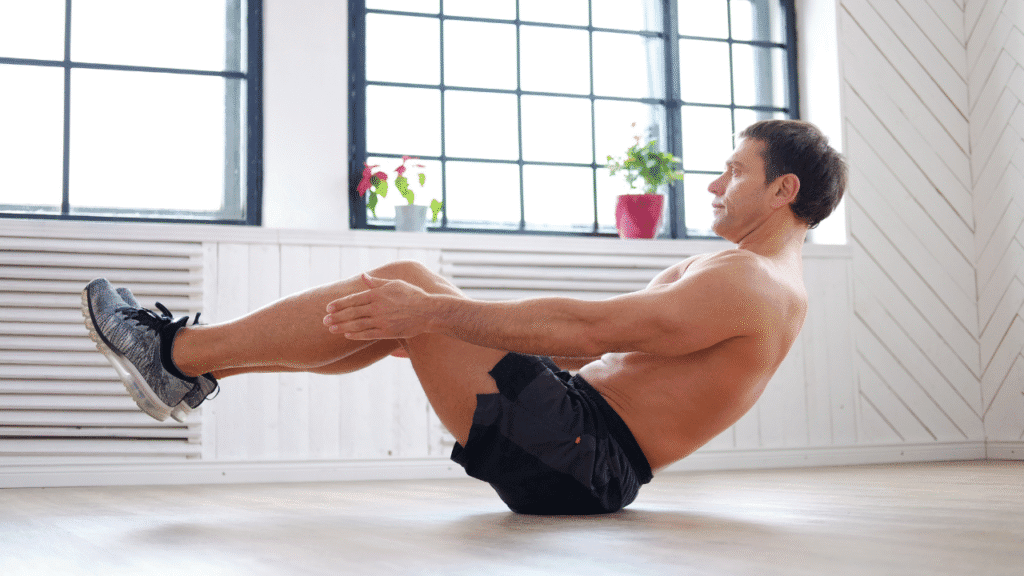How to Do Seated Knee Tucks for Lower Abs

Yo, what’s up legends! Today we’re diving into one of the most underrated ab-blasting moves you can do ANYWHERE — Seated Knee Tucks! No fancy gym equipment, no excuses. Just you, your grind, and the will to sculpt rock-hard lower abs 🔥
If your goal is to tighten that core, define those V-lines, and feel the burn deep in your lower abdominals — you’re in the right place. This move might look simple, but done right, it’s a core killer!
Here’s the deal — most people struggle to activate their lower abs properly. Crunches? Meh. Sit-ups? Overrated. But seated knee tucks? They target your lower core like a heat-seeking missile 🎯
I’m breaking down everything — perfect form, common mistakes, progressions, pro tips, and how to make seated knee tucks a part of your no-equipment ab arsenal.
1: Understanding the Move
Seated knee tucks are a bodyweight movement designed to target the lower abdominals, while also activating your hip flexors, quads, and even stabilizer muscles in your core and lower back.
What’s happening here is compression. You’re pulling your knees in toward your chest while keeping your upper body slightly leaned back — engaging your abs every inch of the way. That contraction? That’s where the magic happens.
It’s minimal. It’s controlled. And it’s savage.
You’re essentially creating a V-shape motion with your body. But don’t let the simplicity fool you. If you’re doing it right — the burn will hit by rep 10.
Best part? You can do this move anywhere. Living room, dorm room, hotel, office break room, you name it. Just sit on the edge of a bench, bed, or floor mat and go.
2: Setting Up Perfect Form
Let’s get into the form.
Sit on the edge of a flat surface — floor, mat, or bench.
Place your hands slightly behind you for balance, fingers pointing forward.
Lean back just a bit — not too much. Think 45 degrees.
Lift your feet off the ground — knees slightly bent.
Engage that core like you’re bracing for a punch. Now, bring your knees toward your chest.
💡 PRO TIP: Keep your movements smooth and controlled. No jerky motions.
Exhale as you bring your knees in. Inhale as you extend them out. Keep that core tight the whole time. Don’t arch your lower back or slump your shoulders — posture is key here!
This is where quality > quantity. Even 10-12 solid reps can hit harder than 30 lazy ones.
3: The Muscles You're Targeting
Time to nerd out a little — the anatomy of this beast.
Here’s what’s firing during seated knee tucks:
Rectus Abdominis (Lower Abs): The main show. These are the “six-pack” muscles.
Transverse Abdominis: Deep stabilizing muscles of your core.
Hip Flexors (Psoas & Iliacus): Responsible for lifting those legs.
Obliques (if you add a twist variation).
Quads & Lower Back: For support and stability.
The seated knee tuck lights up your entire midsection, but especially zones in on that lower pooch area most people struggle to tighten.
This move also forces your body to balance while under tension — so your core stability skyrockets over time.
Want better posture? Stronger lifts? A tighter waistline? This exercise is a key that unlocks all of that
4: Common Mistakes to Avoid
Even the most fire move can be wrecked by poor form. Watch out for these rookie errors:
🚫 Relying on Momentum – Swinging your legs kills core engagement. You’re not at a playground. Keep it controlled.
🚫 Slouching Shoulders – Hunching forward puts stress on your neck and spine. Keep your chest proud and shoulder blades slightly back.
🚫 Overarching Lower Back – If you feel pain in your back, you’re probably arching. Tuck your pelvis slightly and engage your core.
🚫 Holding Your Breath – Proper breathing enhances control and stamina. Exhale on the tuck, inhale on the extension.
🚫 Feet Touching Ground Every Rep – Keep your feet off the ground to maintain tension. Let those abs do the work.
Fix these mistakes, and you’ll instantly feel the move hit harder — where it should.
5: Progressions for Beginners
New to this? No worries — we’ve got modifications.
✅ Single-Leg Tucks: Alternate one leg at a time. It reduces the load while still targeting your core.
✅ Hands-On Floor, Closer to Hips: Increases stability. The closer your hands are, the more support you get.
✅ Back Supported Tucks: Use a sturdy couch or wall behind you for support. Just lean back slightly and perform the move.
✅ Foot Taps Between Reps: Allow your feet to tap the floor lightly between reps to reset. Then work toward keeping them elevated.
Everyone starts somewhere. The goal? Keep pushing till you can do 3 sets of 15-20 reps without tapping the ground.
6: Next-Level Variations
Let’s level up for the advanced warriors 💥
🔥 Weighted Knee Tucks: Hold a dumbbell between your feet or use ankle weights. Game changer.
🔥 Twisting Tucks: Add a twist to each side as you bring your knees in. This lights up your obliques.
🔥 V-Tucks: Extend legs and arms fully and bring them together like a V-sit. Massive core engagement.
🔥 Tempo Tucks: Slow down the motion — 3 seconds in, 3 seconds out. Total burn mode.
🔥 Tuck + Hold: Hold the tucked position for 3-5 seconds each rep. That time-under-tension? Serious core control.
7: Programming Seated Knee Tucks Into Your Routine
Here’s how to integrate them smartly:
✅ Beginner Routine
3 Sets of 10–12 reps
Rest: 30 seconds
Frequency: 3x/week
✅ Intermediate Routine
4 Sets of 15 reps
Add a twisting tuck variation
Rest: 20 seconds
Frequency: 4x/week
✅ Advanced Core Circuit
Superset with:
Plank (1 min)
Bicycle crunches (20 reps)
Seated Knee Tucks (15 reps)
Repeat 3-4 rounds
No rest between moves. Feel the fire.
Add this into your HIIT sessions, post-leg day finishers, or morning fasted cardio routine.
8: Seated Knee Tucks for Fat Loss?
Real talk: Seated knee tucks strengthen and build your core, but they don’t magically melt belly fat.
Fat loss? That comes from a calorie deficit, clean eating, and consistency.
What knee tucks will do:
Build muscle in your core
Tighten your lower abs
Improve posture
Help reveal your six-pack once the fat drops
Pair this move with proper nutrition, cardio, and compound training — and boom 💥 shredded abs incoming.
9: Mobility & Warm-Up Tips
Before you dive into the grind — warm up!
🚀 Dynamic Warm-Up (5 mins)
Standing leg swings (15 per leg)
Torso twists (20 seconds)
High knees (30 seconds)
Cat-Cow Stretch (30 seconds)
Glute Bridges (10 reps)
Mobility matters — a tight hip flexor or stiff spine can throw off your form and reduce range of motion. Stay limber.
After your session? Cool down with:
Cobra stretch
Child’s pose
Supine spinal twist
It’ll keep soreness in check and your spine happy.
10: Seated Knee Tucks Challenge
Let’s put your core to the test.
⚡️14-Day Seated Knee Tuck Challenge⚡️
Day 1–3: 3 sets x 12 reps
Day 4–6: 3 sets x 15 reps
Day 7–9: 4 sets x 15 reps
Day 10–12: Add twists
Day 13–14: Go for time — 30 seconds AMRAP (as many reps as possible)
Track your reps. Watch your form. Feel the gains. Post your progress and tag it with #SeatedTuckChallenge on socials — let’s build that community vibe.
Alright, fam — that’s a wrap on Seated Knee Tucks for Lower Abs!
Whether you’re a beginner just getting started, or a seasoned lifter looking for no-equipment ab work — this move has a spot in every routine.
Keep the form tight. Keep the reps clean. And stay consistent. These tucks will carve your lower abs like stone if you stay dedicated 💯
Make it fun. Make it sweaty. Make it YOU.
Men’s trending fashion and how to look attractive. Here teaching fashion, so make sure to check it out.
Men’s Fitness tips, what you eat and how to stay fit your body. The best workout and best diet plan, so make sure to check it out.
Men’s lifestyle tips, how to live a better life, and changing your lifestyle tips, so make sure to check them out.
It cannot be denied that men have finally come to their senses when it comes to good grooming and fashion statement.
Men are also equally frustrated with bad hair days in their life, even though not as annoyed as women. Even though men have short haircuts, they also face problems in maintaining their hair.
There are no formulae for success but there are some successful entrepreneur tips that can help make things a little simpler.









